Using this automation, you will assess customers who have recently bought a particular product, goods from a specific category, or goods from a particular manufacturer in your e-shop. You can offer them products related to their previous purchase to enhance their shopping experience or provide assistance with the products or services they acquired from you.
Goal of automation
The goal of remarketing automation is to offer related products to customers after they have purchased a certain type of item in your store. It also aims to try and maintain the interest of customers who are actively making purchases by personalizing and targeting relevant products as well as by providing promo codes.
For example, you can provide after-sales services like extended warranties or insurance. Additionally, you can send customers information related to their purchase, such as video tutorials, how-to guides, messages inviting them to join your product or service community, or other related content.
The automation includes one or more motivational emails. Optionally, you can categorize recipients who successfully complete the automation by making a purchase. They can be assigned to a group with a specific activity level for future reference.
Prerequisites
To create an automation, you will require:
- Activated Boldem Profi plan.
- E-shop or other kind of site integrated with a Boldem account.
- Fully verified sending domain.
- Transactional template – the message you intend to send to the recipient.
- Promo codes (optional) – if you decide to offer promo codes to customers as a part of your automation, you will need to add them first.
See the sections below for details on each step.
Integrating website or e-shop with your Boldem account
To ensure that Boldem can efficiently retrieve data from your website (e-shop or other systems), and make the most of its features, including automation and subscription forms, you must first integrate your website with your Boldem account. The following options are available:
- Generic integration that enables you to embed a form on your website for data collection.
- Instant integration of your e-shop with the Shoptet or Upgates platforms to seamlessly sync your contact database, cart, and order data.
- Extended integration of any website or e-shop on any platform, allowing, in addition to subscription form display, also, e.g., synchronization of contacts, order, or cart data. However, this integration requires the intervention of a developer who will create a customized integration for you.
A Boldem account with theProfi plan or higher is required for full functionality of the integration (the Standard plan only allows synchronization of recipients with ready-made integrations). You can upgrade to the Profi plan at any time via Billing. If you encounter difficulties when upgrading to a higher plan, please contact your salesperson or our customer support via email, phone, or chat.
Below, you will find instructions on how to integrate different platforms with your Boldem account:
- Integrating your Shoptet store with Boldem.
- Integrating your Upgates store with Boldem.
- Integrating other websites with Boldem.
Transactional template
Only so-called transactional templates can be used in automations. Any smart template can be set up as a transaction template. The prerequisite for a successful transactional template is a fully verified sending domain. You can manage the sending domain in Settings/Domains.
You can make a transactional template by following the procedures below. This method also allows you to modify an already existing smart template. If you wish to work with an existing template, open it and continue with step 4:
- Log into Boldem and navigate to Templates.
- Click Create a new template and select Create a smart template.
- Choose whether you want to edit a ready-made template from the gallery, start working with a sample template, or start from scratch with a blank template.
- Click the gear icon. The Information tab then appears.
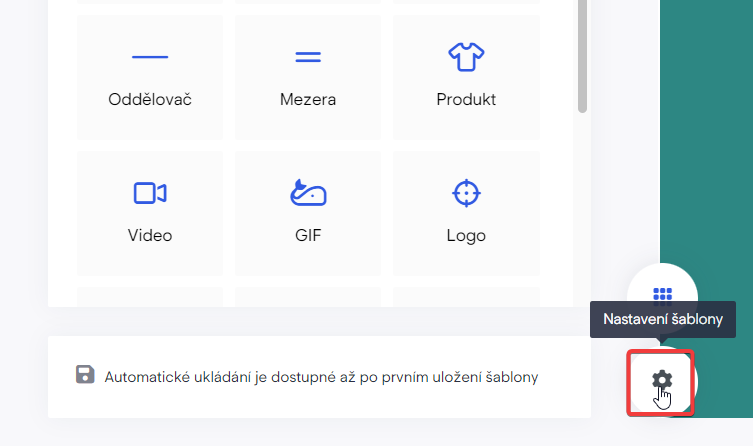
- On the Information tab, fill in the template name, subject, and preheader.
To make it easier to locate your template in the list, we suggest naming it according to the context or scenario in which you intend to use it within your automations.
- Activate the transactional features by toggling on the Template is for transactional emails (automations and API) switch. This action will reveal additional transactional template fields.
- Fill in Sender’s email, Sender’s name, and select your Domain router from the drop-down menu.
Enter a working email address as the sender’s email. This email address must belong to a domain that you have previously verified within Boldem. To add or verify a domain, navigate to Settings/Domains.
- In the upper right corner, click Done and select Save and leave.
Inserting products into template
You can add products to the template not only manually, but also directly from the data source of your e-shop. This option will be available after integrating your e-shop with your Boldem account. Additionally, you can add any other data source at any time in the Settings/Data sources section.
You can then insert products into the template via the Product block. If you have not selected one of the pre-made templates from the gallery, drag the Product block into the template body first. The procedure is as follows:
- Open the template you want to edit or create a new one.
- Click the ᎒᎒᎒ grid button to view the content blocks.
- From the block menu, drag the Product block into the template on the right.
- Click on a block on the right to view its properties.
- Click the Product import tab to view the contents of the product data source.
- Select the product you want to insert or enter a keyword in the search. You can also search using other criteria by toggling on the Advanced filter switch.
- Have a look at the other tabs and customize the block settings to your preferences.
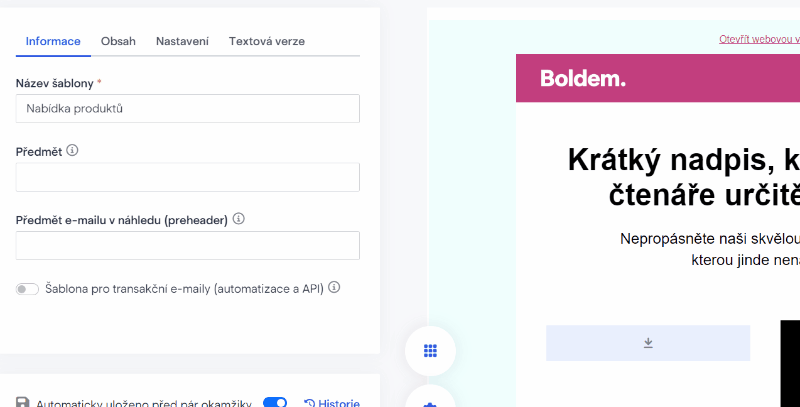
Duplicating a product block or any other block is simple. Hover over the block and click on the ⎘ duplicate icon in the toolbar.
Promo codes
If you decide to motivate your customers to make purchases using promo codes, it is practical to assign a unique promo code to each customer. Before incorporating promo codes into a template, you must input them into the system, either through manual entry, or by importing them from a file:
- Go to Settings/Promo codes.
- Click All groups and select Add group.
- Enter the group name, select the group color, and confirm with Add.
- Click New promo code.
- Choose an expiry date in the Select expiry date drop-down menu. The date should match the date you have opted for in the online store, through which promo codes are being generated.
- No expiration – all imported promo codes can be used for unlimited time.
- Single expiry date – there is a set expiry date and time for all imported promo codes. Once selected, a field will appear and further request a date to be specified.
- Individual expiry date – each imported promo code has a defined expiration date and time. To proceed with this option, two columns in the imported file must be filled in: one with the promo codes, and one with the expiry date(and time).
- If you wish to import a file containing promo codes, click Select a file and confirm by clicking Create.
The promo codes file must be in Excel, CSV, or TXT format. There, the codes have to be stored separately on each row. Optionally, the expiry date in the file can be in the format used in your account (see Settings/General/Basic/Settings – Date and time format), or in the default English format mm/dd/yyyy. The expiry date will only be taken into account if you have selected the Individual expiry date option.
- A small number of promo codes can also be imported manually by entering them into the Promo codes field. If this is the choice you opt for, make sure each promo code is written on a separate row. If you also wish to add an expiry date after the promo code, choose Individual expiry date from the Select expiry date drop-down menu and add a semicolon ;, or a vertical bar | after the promo code. Behind this special character, insert the date and time format set in your account (see the note above), e. g.:
PromoCode12|29.3.2028 12:00
- Confirm the dialogue by clicking Create.
Using promo codes in template
Promo codes can be sorted into groups, each of which can be assigned different colours and names. Every group carries a unique identifier, e.g. {{coupons.group_794}}. Copy and paste the string into the templates you plan to use in campaigns or automations.
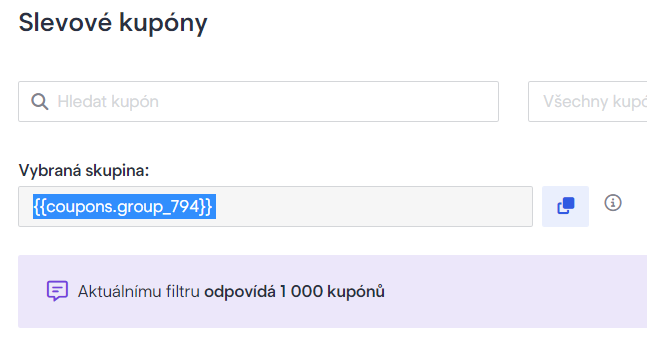
In the template, paste the copied identifier into the area of your liking. After dispatching a campaign, triggering an automation, or dispatching transactional emails, these identifiers will then show as unique promo codes.
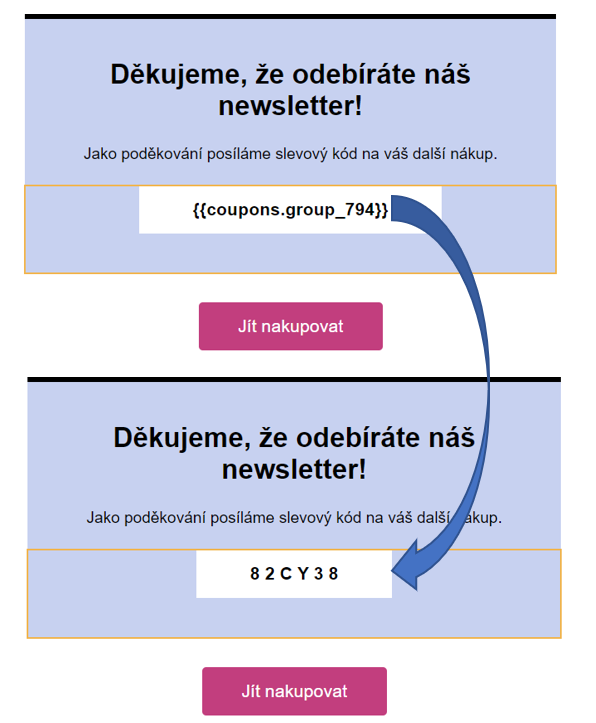
Personalized salutation in template
When creating a template to send to your customers, always consider how the salutation at the beginning will appear to your recipients.
Automatic declension of first names
In Boldem, declension of nouns is done automatically up until the 5th grammatical case, vocative. The variable Vocative is therefore used to generate a salutation. You use this variable by inserting the following string into the template:
{{ vokativ contact.name }}
After dispatching the message, this string will be replaced with the recipient’s first name in the correct vocative form. For example, if the recipient’s first name is Jana, the template will display Jano. Alternatively, if you want to choose a more familiar approach with Hi Jano, use the following string:
Hi {{ vokativ contact.name }},
For example, if your goal is to express gratitude for registering, use the following string:
Thank you for your registration, {{ vokativ contact.name }}!
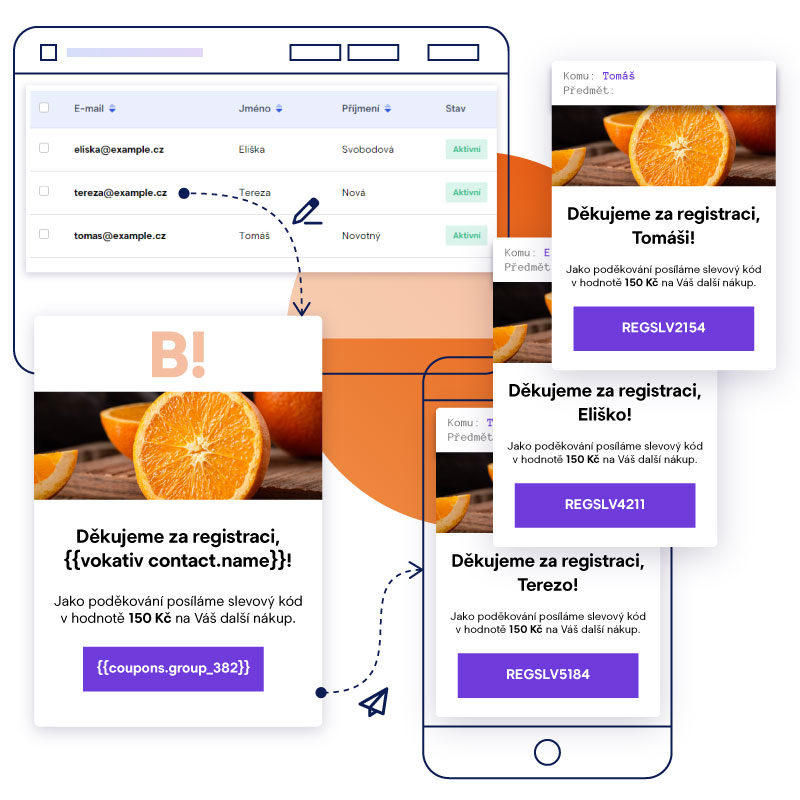
Automatic declension of surnames with gender distinction
In a vast number of personalized salutations, not only do you need to correctly spell both the first and last names, but also to change the salutation to match the person’s gender. Since Boldem allows you to enter the gender of recipients, using the designated variable should make this process a walk in the park.
In certain cases, the gender of the recipients is automatically stored according to the first or last name entered (e. g. during manual insertion or optionally during bulk import). In the case of non-standard names, the gender is not automatically set. Therefore, it is advisable to verify those names first and add the names manually if needed.
If you have set the gender of your recipients, you can use the string below in the template instead of manually addressing recipients:
Thank you for your registration {{ if contact.sex != null }}{{ if contact.sex == 1 }}, Mr. {{ end }}{{ if contact.sex == 0 }}, Mrs. {{ end }}{{ vokativ contact.surname }}!{{ else }}!{{ end }}This string is actually a script code that evaluates whether the recipient has the correct gender setting, thus applying the salutation accordingly:
- If the gender is set to Male and the recipient’s last name is Novák, the following salutation will be used: Thank you for your registration, Mr. Novák!
- If the gender is set to Female and the recipient’s last name is Svobodová, the following salutation will be used: Thank you for your registration, Mrs. Svobodová!
- If gender is not set, the following universal salutation is used: Thank you for your registration!
You can, of course, modify the text of the salutation (bold text in the example) to your liking. We recommend that you always test the salutation thoroughly on a small sample of test recipients using every possible variation (i.e. with both genders and a recipient without gender).
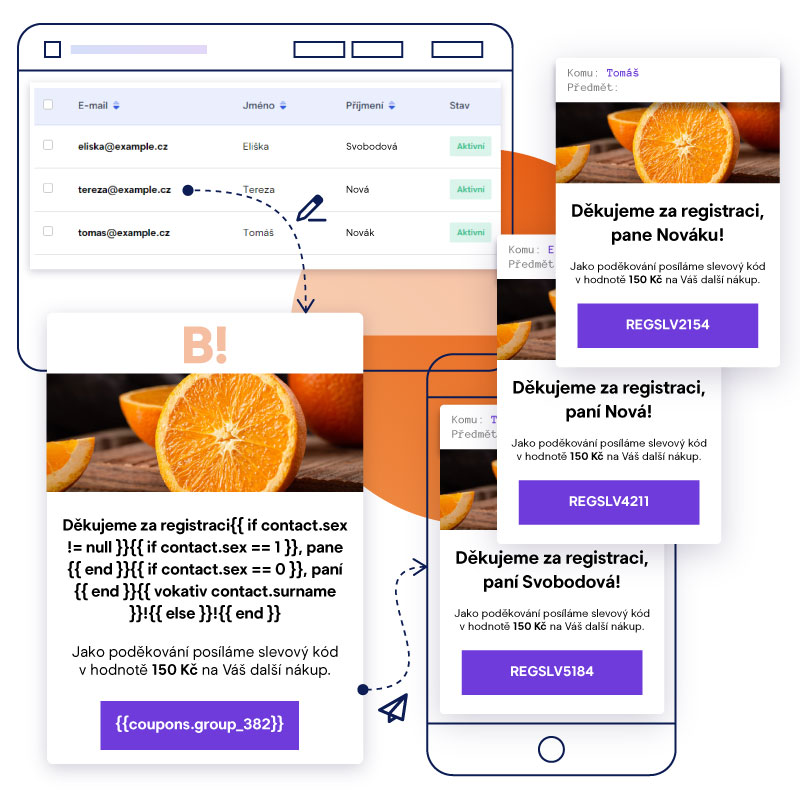
Automation scenarios
Before constructing an automation scenario, define your objectives. Choose the time frame for evaluating customer purchases, identify the category or specific items they have bought, decide on the number of emails to send, consider whether you will include promo codes and the discount amount, etc. You have the flexibility to tailor the automation to your preferences.
Below, we have provided examples of automation scenarios you can create for the purpose of remarketing and offering related items. However, this list is not exhaustive, and you have the flexibility to have the individual automation blocks align with your specific requirements:
- Offering related products to customers who have purchased in the last 30 days.
Automation scenario – offering related products 30 days after purchase
This automated remarketing campaign will assist you in providing related products and, potentially, a promo code offer to customers who made a purchase from a specific category within the last 30 days.

Creating automation
- Log into your Boldem account and navigate to Automations.
- Click Create new automation.
- Enter the Automation name and description. Both entries are for your reference and can be changed later on the Settings tab in the automation details.
- Confirm your entry by clicking Create automation.
The automation diagram opens, providing an overview of the blocks available for use in the automation on the left and a canvas where you can insert these blocks on the right. To insert a block, you can simply drag and drop it onto the canvas.
Remember that the automation does not save automatically. Therefore, we strongly recommend that you save your work continuously by clicking Done/Save. You can edit the automation as much as needed, and it will only activate when you click the Run button.
Trigger
First, we need to add a trigger block to specify how and how often the recipient will enter the automation. To create a remarketing automation, use the Website event block.
- Select the Triggers tab on the left, drag the block Website event block onto the canvas, and double-click it to display the block settings.
- In the Select a website drop-down menu, select the previously integrated e-shop. If you do not see the e-shop in the menu, it may not have been integrated correctly. Verify the status in Settings/Integrations or integrate an e-shop with Boldem.
- In the Select an action drop-down menu, select User has completed the order.
- In the How many hours after the event should this trigger be started? field, specify when the trigger should be activated. In other words, enter the number of hours that should pass since the customer completed the order. Keep the default and minimum value of 2 hours, as the other time condition will be evaluated separately in the following blocks.
- Optionally, toggle on the Run automation repeatedly switch. This setting ensures that the system continuously monitors completed orders for all recipients. Before choosing this option, consider whether it makes sense for your specific e-shop to repeatedly offer related products to the same customers.
- In the After how many days can the recipient go through the automation again? field, enter 60 days.
- Click Save.
Inserting first delay
For the purposes of remarketing automation, we need to insert a delay after a completed purchase before sending any messages. In this case, it is a 30-day delay.
Delay insertion procedure:
- Select the Operators tab on the left, drag the Wait block onto the automation canvas, and double-click it to display the block settings.
- From the drop-down menu, select Over a period of time , and select a delay, e.g., 30 days.
- Click Save.
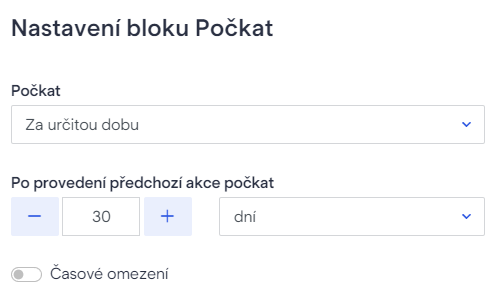
Inserting first condition block
After the first delay set above, we want to evaluate what the recipient has purchased. To do so, we can check the following:
- If the recipient has purchased specific goods (by name or product ID)
- If the recipient purchased goods from a specific category (by category name)
- If the recipient purchased goods from a specific manufacturer (by manufacturer name)
The specific choice depends on your needs. In our example, we will choose goods from a specific category. Thus, we will incorporate a condition block into the automation:
- Select the Operators tab on the left, drag the Condition block onto the automation canvas, and double-click it to display the block settings.
- Click Select a new condition. A dialog will open to select the condition.
- Select Recipients’ activity on the web from the Source drop-down menu.
- In the Select a website drop-down menu, select the previously integrated e-shop.
- From the Recipients’ activity on the web drop-down menu, select Purchased goods from category.
- Choose how you want to assess the category name from the Condition drop-down menu. In our case, we want a specific category, so choose Equals to.
- Enter the exact name of the category from our e-shop in the Category field. E.g. Clothing.
- In the Time limit drop-down menu, select the time period after which the condition should be evaluated. In our case, we want to evaluate the last 30 days. Therefore, select In the last X days, and enter 30 days.
- Click Save rule.
- Click Save to save the entire block.
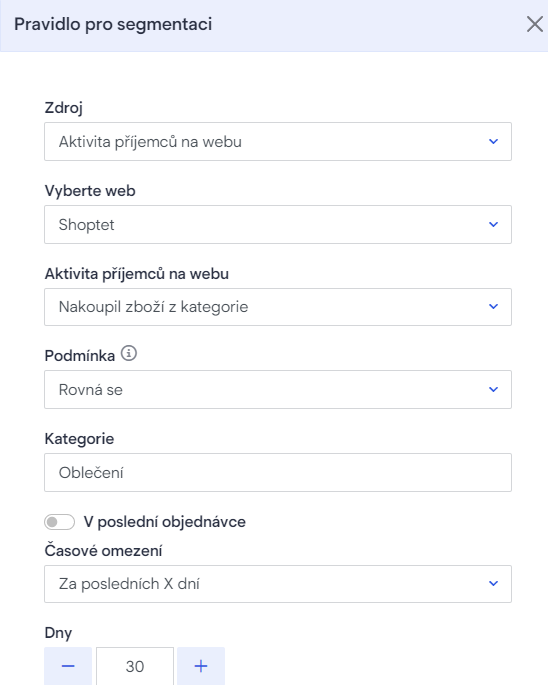
After the condition block, insert additional blocks that take the automation’s evaluation into account. We have two branches – one for a negative and one for a positive result:
Condition block branch – No
If the recipient does not meet our condition, meaning they have not bought a product from the Clothing category within the last 30 days, the automation ends for them as there is nothing left to offer them.
First condition block branch – No
If the recipient meets the specified condition, meaning that they have purchased products from the Clothing category in our store within the last 30 days, we want to send them a series of related emails.
Sending first email
Now, we will add a block to send an email that encourages the recipient to continue shopping for related products, make use of a promo code, or enhance their experience with the purchased product, such as through instructional videos. Your choice should align with the condition you set above.
- Select the Actions tab on the left, drag the Send email block onto the automation canvas, and double-click it to display the block settings.
- Select the transactional template you want to send to the recipient from the Template drop-down menu.
- Leave the other settings as default and click Save.
If for some reason you do not want to send more emails, you can consider the automation complete. In this case, continue with Testing and running the automation.
Inserting second delay
Enter the parameters for the second delay, i.e. the pause between sending the first and second emails. Set this delay based on your specific needs and the content you send to your customers. It is important to strike a balance – give your customers enough time to respond to the first email, but do not make the delay too long, especially if the content of the two emails builds upon each other. In our example, we will use a 7-day delay.
- Select the Operators tab on the left, drag the Wait block onto the automation canvas, and double-click it to display the block settings.
- From the drop-down menu, select Over a period of time , and select a delay, e.g., 7 days.
- Click Save.
Inserting second condition block
After the 7-day delay we set earlier, we need to evaluate whether the recipient has purchased goods according to our parameters – e.g. from a certain category, from a certain manufacturer, or a specific type advertised in the email. In our example, we sent an email promoting items from the Clothing accessories category. To do this, add a condition block to the automation. Here is how:
- Select the Operators tab on the left, drag the Condition block onto the automation canvas, and double-click it to display the block settings.
- Click Select a new condition. A dialog will open to select the condition.
- Select Recipients’ activity on the web from the Source drop-down menu.
- In the Select a website drop-down menu, select the previously integrated e-shop.
- From the Recipients’ activity on the web drop-down menu, select Purchased goods from category.
- Choose how you want to assess the category name from the Condition drop-down menu. In our case, we want a specific category, so choose Equals to.
- Enter the exact name of the category from our e-shop in the Category field. E.g., Clothing accessories.
- In the Time limit drop-down menu, select the time period after which the condition should be evaluated. In our case, we want to evaluate the last 7 days. Therefore, select In the last X days, and enter 7 days.
- Click Save rule.
- Click Save to save the entire block.
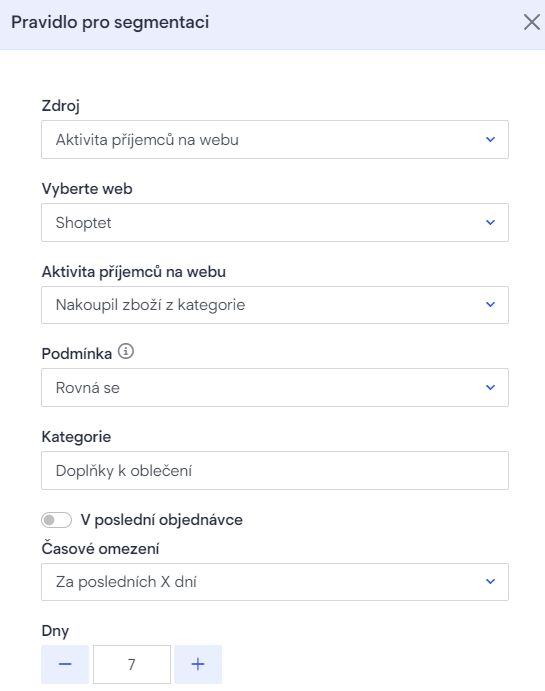
After the condition block, insert additional blocks that take the automation’s evaluation into account. We have two branches – one for a positive and one for a negative result:
Second condition block branch – Yes
If the recipient meets the condition you have set, such as making a purchase in your store within the last 7 days in the Clothing accessories category, you can leave this branch empty, as any further notification is not required. In this case, the automation concludes for the given recipient.
Second condition block branch – No
If the recipient does not meet the specified condition, meaning that they have not purchased products from the Clothing accessories category in your store within the last 7 days, add a block behind this branch to send them a second email.
In the next email, try maintaining the same style as the previous one. For instance, you could give it a sense of urgency: emphasize that a discount on related products will expire soon or that there’s limited time to get an extended warranty. This encourages recipients to act quickly.
- Select the Actions tab on the left, drag the Send email block onto the automation canvas, and double-click it to display the block settings.
- Select the transactional template you want to send to the recipient from the Template drop-down menu.
- Leave the other settings as default and click Save.
This could conclude the automation, but keep in mind that you have the flexibility to adjust the number of conditions, delays, and emails as per your requirements. If necessary, simply repeat the previous steps.
If you wish to monitor recipient activity using a custom index, you can create a custom field and allocate a value to it using the Edit recipient block. For information on creating and using custom fields, see Custom fields.
Similarly, you can insert recipients into another mailing list if you want to e.g. sort the active recipients. To do this, use the action Edit mailing list.
Testing and starting automation
Connect the automation blocks by clicking and dragging the mouse:

You can further customize the automation according to your preferences, e.g. change the number/types of emails, conditions, and the delays over time. Simply test what works best for your customers.
Once you are satisfied with the settings and number of blocks, save the automation by clicking Done/Save.
Test the automation thoroughly before starting! Testing procedures can be found in the article Testing automation. We recommend not to underestimate testing and to start the automation only after proper testing.
Once you have completed the testing with a positive result, run the automation by clicking Run.
For general information on how to work with automations, see How to work with automations in Boldem.